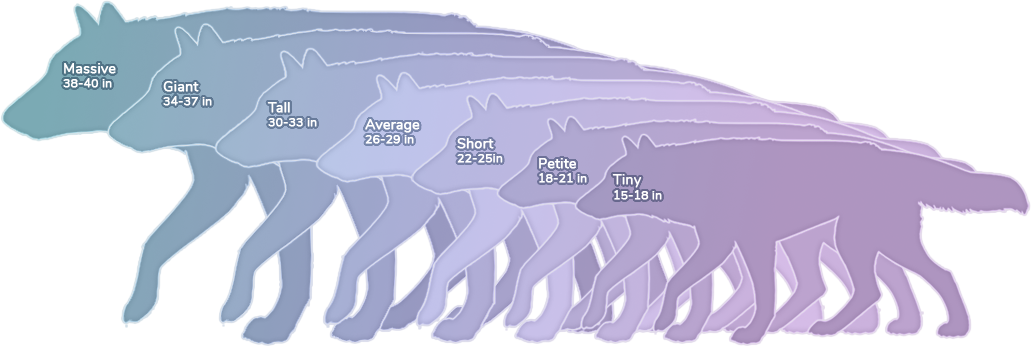Wolf Guide
Nocturne focuses on canine roleplay, specifically gray wolves or coyotes. There are a variety of sub-species of gray wolf and you are welcome to use any that are included in our guide. We accept one variant of coyote, and details of each species we accept are listed below. Make sure to check out our Creation Guide and Marking Guide for guidance on character design.
Sub-species not listed here may still be permitted, but we do not allow extinct species. It must be a living sub-species of gray wolf.
One exception: coyotes cannot be larger than average.

[ view full image ]
We recommend that you check out our article on Growth and Development for more information about the different lifestages.
| Species | Weight | Height |
|---|---|---|
| Arctic Wolf Canis lupus arctos |
90-125 lbs | 25-31 inches tall |
| British Columbian Wolf Canis lupus columbianus |
100-125 lbs | 30-36 inches tall |
| Cascade Mountains Wolf Canis lupus fuscus |
80-90 lbs | ~36 inches tall |
| Eastern Timber Wolf Canis lupus lycaon |
65-85 lbs | 26-32 inches tall |
| Great Plains Wolf Canis lupus nubilus |
80-110 lbs | 26-32 inches tall |
| Mexican Wolf Canis lupus baileyi |
50-80 lbs | 26-32 inches tall |
| Northern Rocky Mt. Wolf Canis lupus irremotus |
85-115 lbs | 32-40 inches tall |
| Rocky Mt. Wolf Canis lupus occidentalis |
100-132 lbs | 32-40 inches tall |
| Southern Rocky Mt. Wolf Canis lupus youngi |
100-132 lbs | 26-30 inches tall |
| Red Wolf Canis rufus |
50-80 lbs | 24-26 inches tall |
| Coyote Canis latrans |
15-46 lbs | 21-25 inches tall |
Sub-species not listed here may still be permitted, but we do not allow extinct species. It must be a living sub-species of gray wolf.
Wolf Sizes
As seen in the chart below, wolves come in a variety of sizes on Nocturne. This expansive range allows for variance in characters and a bit of a stronger dynamic between interactions. For example: a massive wolf fighting a coyote puts the wolf at an undeniable advantage. In addition, a dam who breeds with a sire who is too much larger than herself may face complications during copulation and birthing. The species you choose doesn't have to fit the size of your character, but it is recommended.One exception: coyotes cannot be larger than average.

Lifespan
Wolves on Nocturne can live a long time, with the maximum age capping at 14 years. Keep in mind, however, that 14 is incredibly old for any canine and most wolves will pass of natural causes by around 9 years old. In order for a wolf to thrive past that age, they must have great health and be supported by a family unit.We recommend that you check out our article on Growth and Development for more information about the different lifestages.
| Wolf Age | Human Age | Wolf Age | Human Age |
|---|---|---|---|
| 0–1 month | 0–2 years | 4 years | 34 years |
| 2 months | 2–4 years | 5 years | 38 years |
| 3 months | 4–6 years | 6 years | 42 years |
| 4 months | 6–9 years | 7 years | 46 years |
| 5 months | 10–12 years | 8 years | 50 years |
| 6 months | 13–15 years | 9 years | 54 years |
| 7 months | 15–16 years | 10 years | 60 years |
| 8 months–1 year | 16–17 years | 11 years | 64 years |
| 1.5 years | 18 years | 12 years | 70 years |
| 2 years | 24 years | 13 years | 74 years |
| 3 years | 30 years | 14 years | 76 years |
Last Edited: June 28, 2025
Editor: Carey
 Late Summer Y0 |
Sunny |
95°F / 35°C
Late Summer Y0 |
Sunny |
95°F / 35°C










